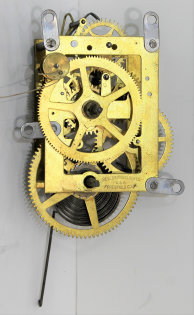
230. $500
Dickory Dickory Dock Clock, Model IV, ca. 1910. Elmer Dungan designed the first mouse clock around 1900 and partnered with Charles Klump, who felt they had commercial potential. Early models were produced by the New Haven Clock Co. but did not perform well; these early models had a 2-day time-and-strike pendulum
movement in the bottom of the case. In 1910 D&K patented Model IV, and that is the one offered here. Sessions Clock
Co. made the time-only movement, an 8-day time-only, pendulum-regulated, spring-driven movement positioned at the top of the case. In this model the clock only strikes on the ‘one’ (as in the nursery rhyme), triggered by the release and fall of the mouse. Horolovar made replicas of this clock in the 1970’s; that clock has a platform lever movement and is more commonly seen. Here
is my web source for this information, based on an article by Charles Terwilliger (Horolovar) in NAWCC Bulletin Supplement No. 4.
The oak case is 35 inches long and 8.5 inches wide. The finish is very dark, as originally intended (early models were painted
black), and it has a Mission-style appearance. The numbers are brass, the lettering and gradations on the scale were gold at
one time. The title, “Dickory Dickory Dock” is barely visible at the top; below it is patent information for 1909. The
mouse needs a bath and has a string tail. The upper winding arbor turns a spool that controls the position of the mouse; you
can move it up or down. The lower arbor winds the spring, which slowly turns a gear behind the spool, winding up the string
that pulls the mouse up the clock. When it reaches a gap in the gear the spool unwinds and the mouse falls to the bottom, and
the climb starts over as the spool gear turns and reengages. As the mouse reaches the top (the number 1) it lifts a strike hammer
and when the mouse falls the hammer strikes the bell. Voila, the clock struck one and the mouse ran down! The clock is
running but out of plumb, and it is difficult to restart a stopped pendulum. There is a wood backboard that is easily removed
to access the movement and pendulum, and a partial label on the fixed bottom half of the backboard that presumably gave instructions;
the maker’s name is missing (but it’s no secret to us now!).
I don’t know, do kids know this nursery rhyme these days? If so, your grandkids might find this amusing, if they have the patience to wait for the mouse to reach the top. I could only
find one sales record for this model, in 2013 at Copake Auction for $575. There are lots of sales of the Horolovar replicas
made in the 1970’s. Because this is a rare model and is the last significant production model made by Dungan & Klump, and
it is working, I’m starting it at $500. For that you could buy your grandkids a computer tablet instead, and they’d probably
be happier! $500-$1000.



Antique American Clocks July 2022


